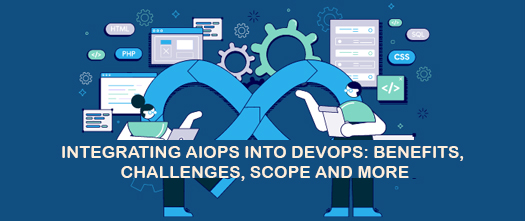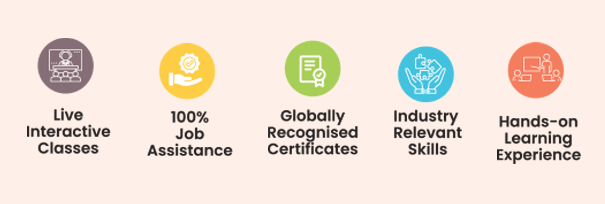There exists a rapid surge in initials containing the “Ops” suffix in the past decade, which began with the amalgamation between development as well as operational IT (DevOps). This convergence of specialties aided businesses in understanding their processes, improving the calibre of their production, and operating at a rate that is far greater.
While coordination as well as tracking are critical components of development and operations, the increasing trend of leveraging computational intelligence, better known as Artificial Intelligence (AI) to aid and automate operational activities by supplying real-time data concerning what occurs to your system appears to be on par. In order to allow quick repetition of the creation and repetitive transmission of theories, a simple infrastructure that supports planning, model administration, and straightforward delivery is required. This will increase each developer’s efficiency and allow for the recurrence of themes in the final item.
Defining DevOps
DevOps is a combination of two terms: Dev (development) as well as Ops (operations). DevOps is a collaboration of individuals’ innovations, as well as procedures that strive to give value to consumers at all times. DevOps is a collection of strategies, technologies, and ideas of culture that streamline and link activities amongst the development of software along with IT teams. It, on the contrary, promotes versatility, effectiveness, and adaptability while also maintaining foundation for creation and use. It places a premium on team independence, dialog, cooperation, and technology productivity.
Defining AIOPs
AIOps is defined as a technique that blends artificial intelligence (AI) or algorithms for machine learning, or ML, alongside computing operations to increase the efficacy of overseeing complex IT systems. Enhanced data analysis and automation are used in AIOps to deliver insights, discover oddities, identify structures, generate projections, and aid in diagnosing in IT-related settings.
There are five types of algorithms that AIOPs analyse:
- Data Selection: The process of picking information characteristics that suggest something is amiss from a significant volume of undesirable and chaotic IT data collected in an advanced IT setting, typically sifting as much as 99 percent of this data.
- Pattern Discovery: Pattern Discovery is the procedure of connecting and discovering connections between chosen sensible, and interconnected data items for additional examination.
- Inference: Detecting the root reasons of an occurrence, determining issues, and reoccurring difficulties to ensure you are able to act on your findings.
- Collaboration: Teamwork involves educating essential operatives and organisations, boosting contact within them in specific when the people involved are spatially scattered, and preserving historical information that could be used to speed up the detection of identical issues later.
- Automation: As far as attainable, automation reaction along with cleanup in order to make options both specific and timely.
Merging AIOps into DevOps
AIOps integrates easily with a wide range of currently available resources and procedures, allowing teams to take full advantage of the significance of the different data feeds given by multiple apps and networks. Also, AIOps absorbs and evaluates these numerous points of information in order to figure out the connection they have with one another and properly oversee the equipment to ensure that it is constantly operating appropriately.
Finally, one of the greatest benefits of incorporating AIOps with automation into the way you work is reduced fatigue. Teams are able to concentrate on doing what they enjoy doing best, being inventive and imaginative, rather than constantly dealing with emergencies. Managers who engage primarily on finding solutions are more susceptible to start burning out. Because AIOps is capable of automating these procedures, staff may devote additional time to improving the good or solution and supplying it.
Significance of merging AIOPs into DevOPs
- The simple insertion of Dev as well as Ops components with the AIOps framework as entirety eliminates any potential issues with regard to the visible interaction. This holistic picture enables the project’s general success and attainment of its goals to speed expansion and reaction by guaranteeing that Dev groups comprehend the surroundings better while guaranteeing Ops receive an accurate picture of how and why designers make modifications and put them in operations.
- Switching to cloud computers can be difficult, particularly at an extensive basis in which it is not practical (or acceptable) to put IT entirely in the cloud for all purposes.
- AIOps also does not substitute for preexisting surveillance, log administration, desktop services, or solutions. Rather, it accepts multiple fields, intakes and incorporates data within all, and outputs useful data to ensure that a sync image can be found in all devices. Such instruments are useful, but getting the correct data when you need it can be difficult.
- The notion of robust code coupling challenges for maintaining up with the ever-evolving surroundings of current IT infrastructures.
- AIOps here gives an easier means to bring all of these disparate ideas together to form one holistic picture regarding what IT Ops professionals need to know.
Benefits of Integrating AIOPs with DevOPs
Merging AIOps into DevOps might be an essential tool for firms looking to increase software availability and manage IT operations. Here, we’ll go over the several advantages of the combination in greater depth.
Improvised automation as well as effectiveness in IT services
One of the most significant benefits of combining AIOps along with DevOps is increased automating and effectiveness in operations. Artificial intelligence, machine learning, and other technologies are used in AIOps to streamline mundane operations that include monitoring systems, log examination, and handling issues. Automation not solely minimises the need for manual labour for IT personnel, but it additionally guarantees that regular tasks are completed on a regular basis.
Automation serves as a fundamental drive in DevOps, when quickness and dependability are critical. IT personnel are able to adapt quickly to varying surroundings with AIOps, allowing for speedier software creation, assessment, and distribution. This results in faster introduction for programs and greater competitiveness.
Predictive Analysis and Improved Visibility
AIOps services improve insight across the whole IT landscape, from equipment to performance of applications. They gather and analyse massive amounts of data, providing findings that can be usually difficult to gain manually. AIOps solutions may connect and interpret information collected from various places, resulting in an extensive understanding of the IT ecosystem.
AIOps also excels at statistical analysis. AIOps can spot trends, oddities, and potential difficulties before they progress into major incidents through evaluating data from both the past and the present Teams working in DevOps may employ this information to fix concerns in advance, avoiding outage and service interruptions. Predictive analysis can also help with capacity estimation by guaranteeing that facilities are correctly scaled to fulfil demand.
Quicker Incident Response and Resolution
Minimising the effect of events while decreasing mean-time-to-resolution (MTTR) are critical in a DevOps setting. By delivering live monitoring with automating incident handling, AIOps enables enterprises to fulfil these objectives. When an issue happens, AIOps can immediately identify the source of the problem and initiate automatic responses or warnings.
This additionally speeds up the resolution of incidents but also lessens the workload on IT professionals. Teams working in DevOps can concentrate on more tactical activities while AIOps handles regular response to incidents. AIOps makes IT management adaptable, resulting in greater service reliability.
Resource Allocation Optimization
Another major benefit of combining AIOps and DevOps is better use of resources. AIOps technologies monitor the functioning of IT assets and software in real time. They may dynamically assign resources depending on immediate time, to guarantee applications have everything they need to run optimally while avoiding over-provisioning.
This implies value for money and versatility for DevOps. The allocation of resources is efficient, lowering the expense of infrastructure while guaranteeing that apps can scale to satisfy higher demands without any human intervention. As an outcome, the construction is more nimble and receptive, supporting DevOps goals.
Data-Driven Software Development Decision-Making
AIOps-DevOps convergence is built on data-driven choices. AIOps technologies gather and evaluate massive volumes of data, offering teams working in DevOps with useful information. This driven by data method of developing software has various advantages:
- AIOps can discover slowdowns in apps and structures, allowing DevOps to implement smart adjustments.
- Privacy: AIOps can identify as well as react to dangers to security, assuring that electronic goods stay bug-free.
- The AIOps insights enable ongoing improvements in developing software processes, resulting in better-quality releases.
Future objective of merging AIOPs with DevOPs
The struggle is heating up as AIOps mature from their infancy and provide additional success cases. DevOps is supplanting conventional IT organisations, but the difficulties they encounter are more complex, which is why there are solutions tailored to solve these novel obstacles. In this aspect, AIOps will evolve past its goal of supporting DevOps to accept current scalability and pace in years to come.
Challenges of AIOPs-DevOPs merger
- Cultural transformation: One of the major problems is the needed cultural transformation. DevOps or AIOps are two distinct attitudes and techniques. DevOps is concerned with teamwork and rapid growth, whereas AIOps is concerned with techniques and robotics. Getting organisations to accept this change might be difficult.
- Skill Gap: Successful AIOps implementation necessitates AI plus machine learning competence. To be successful with AIOps tools, teams involved in DevOps might require an upskill, which can be a lengthy endeavour.
- Data Safety and Access: AIOps is strongly reliant on info, and the level of accuracy or accessibility of information sources might vary. It is a huge problem to ensure that information stays precise, readily available, and useful for AIOps analytics.
AIOps will alter things for businesses that move slowly. AIOps poses novel difficulties to the management of IT services, and this trend is expected to continue. AIOps and DevOps are capable of being implemented in tandem to avert challenges, improve the user experience, preserve money, while freeing up IT professionals to concentrate on building excellent products rather than legacy system maintenance. As operations and accessible requirements increase, so does the recognition and tactical significance of the IT staff across the firm.
Are you ready to begin incorporating AIOps with your DevOps group? Grras solutions is prepared to assist tech enthusiasts to make this transition by delivering devices, technologies, and breakthroughs that promote flexibility, acceleration, and excellence. One can join the Advanced DevOps & Cloud Computing Training Course with Grras Solution to secure 100% job Guarantee with this program.






